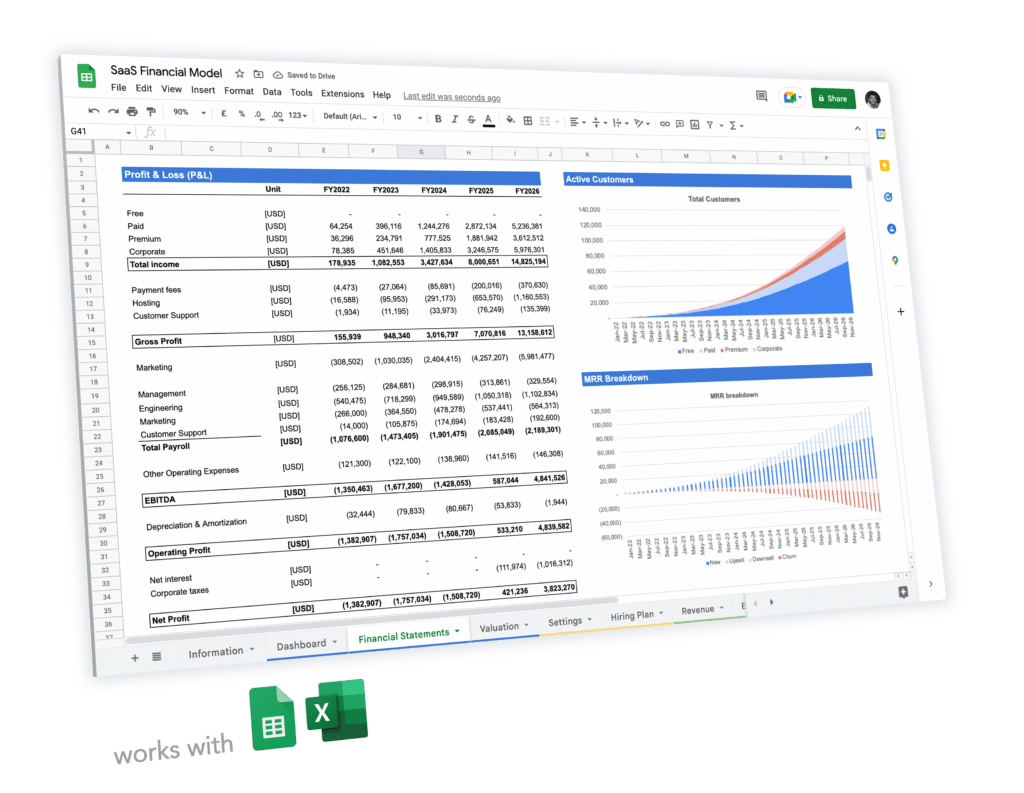Tutorial: How To Forecast Inbound Acquisition? [Free template]

Disclaimer: this article is a step-by-step tutorial for anyone using our financial model templates. If you haven’t yours already, check out our templates here or sign up there and build yours for free.
Forecasting customer acquisition isn’t easy. There are 2 different customer acquisition strategies possible: inbound and outbound.
Inbound acquisition is an acquisition strategy whereby customers are acquired from traffic (visitors). Most business-to-consumer (B2C) online businesses today use inbound acquisition. Mobile apps, SaaS and e-commerce are examples of business models that use inbound acquisition, to name a few.
In this tutorial we explain how to use our templates to forecast inbound customer acquisition for your business (+ a free template). Read on.
Inbound acquisition: What is it?
With inbound acquisition, businesses acquire customers via visitors. Visitors can be in-person traffic (in a retail store for instance), but for most tech businesses visitors are traffic on a website, landing page, mobile app, etc.
Traffic is two fold: paid and organic:
- Paid traffic: all visitors coming from paid marketing channels (Google Search, Facebook Ads, etc.). You are either paying for clicks, or impressions.
- Organic traffic: all visitors landing on your landing page(s) organically (either via a referral link, direct search, social media post, blog article, etc.)
Paid marketing is the easiest way to generate traffic. Yet, because you are paying for each paid visitor, you will need to monitor your Return on Ad Spend (ROAS) to make sure your paid marketing campaigns are profitable.
In comparison, whilst you do not directly pay for each organic visitor, organic traffic is not free. Organic traffic is earned from investment into SEO and content. Whilst investing into your SEO for instance does not pay immediately, the returns can far outweigh those of your paid marketing in the long run.
Step 1: Forecast paid traffic
The first step of inbound customer acquisition is to estimate the first leg of acquisition: paid traffic.
Paid traffic is a function of 2 things:
- Paid marketing budget
- Cost-per-click
1.1. Forecasting paid marketing
Paid marketing is the sum of all your digital ad spend: Google Ads search and Display, Facebook and Instagram, etc. It is the total of all your pay-per-click campaigns.
The 2 parameters you need to set to forecast paid marketing are:
- The first month paid marketing spending: the paid marketing budget of the first month of your budget. For example, if your Google Ads campaigns spend is $3,000 and Instagram Ads is $2,000, your total paid marketing spend is $5,000
- The percentage growth of paid marketing: the month-by-month percentage growth of your marketing spend. For instance, if you spend this month $5,000 and you increase by 10% every month, next month you will spend $5,500
Note: because numbers increase over time, typically the monthly percentage growth decrease over time (see in the chart below).
1.2. Forecasting paid traffic (visitors)
By applying the average cost-per-click of your paid marketing campaigns, we can now estimate how many visitors you will acquire each month. Indeed:
Paid visitors = Paid marketing / Cost-per-click
Now, assuming you pay in average $2.00 CPC for your campaigns, the number of visitors you acquire each month is:
Step 2: Forecast organic traffic
Now that we have estimated the number of paid visitors you will generate on your website or any other type of landing page, let’s have a look at how you should forecast organic traffic instead.
It works exactly the same way as for paid traffic. The only difference is that we don’t have any CPC here. Therefore, the parameters you need to change are:
- The first month organic traffic: the number of visitors you acquire through organic sources. If you aren’t sure where to look, use your last month organic traffic from Google Analytics (see below on how to find it)

- The percentage growth of organic traffic: the month-by-month percentage growth of your organic traffic. For instance, if you have 1,000 organic visitors this month and you expect to increase this number by 30% every month, next month you will spend have 1,300 organic visitors, and so on.
Step 3: Estimate new customers
Once we have calculated both paid and organic traffic over time, the number of customers you will acquire is the result of the simple following formula:
New customers = Total traffic x conversion rate
Using the same example above, and assuming a 2% conversion rate, this is how we would estimate customer acquisition:


 5-year pro forma financial model
5-year pro forma financial model 20+ charts and business valuation
20+ charts and business valuation  Free support
Free support